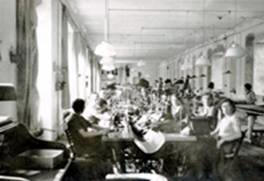|
After 1945 – The End of the Marienthal Textile Factory
The
buildings of the Agricultural Corporation of Gramatneusiedl on the
Marienthal factory grounds were burned down, together with the grain
they contained, by soldiers of the German Wehrmacht (army) immediately before
the liberation of Gramatneusiedl by the Red Army. As a result of these
fires nearly all of the buildings of the former Marienthal textile
factory that still existed then were destroyed. The small Marienthal
textile factory of
Kurt Sonnenschein (1906–195?) started in 1946 in reconstructed
buildings, was taken over by the Viennese textile manufacturer
Justinian Karolyi in 1958, and was completely shut down on March 31, 1961. Today
on one part of the former Marienthal textile factory grounds stands the
Para Chemical Laboratory which employs about 180 workers and produces
acrylic glass since 1962, on the other part there are privately-owned
restaurants, shops, and dwelling-houses.
Click on an image to enlarge!
Take care of the
Copyright!
|

|
Workers in the sewing plant of the former factory of Kurt Sonnenschein,
at that time in the possession of Fritz Ries (1907–1977).
Photo
1940; original 5,2 X 7,6 cm.
Source: Archives for the History of Sociology in Austria (Graz),
Walter Dienstl: Marienthal-Gramatneusiedl picture collection, call
number 43/331.
© Copyright
|
|

|
Workers in the factory of Kurt Sonnenschein, Weaving Mill Marienthal,
Ltd., in a building of the former Marienthal textile factory.
Photo
1950; original 7,9 X 11,5 cm.
Source: Archives for the History of Sociology in Austria (Graz),
Walter Dienstl: Marienthal-Gramatneusiedl picture collection, call
number 43/324.
© Copyright
|
|

|
View
of the grounds of the former Marienthal textile factory (acrylic
glass factory »Para-Chemie« since 1962; on the left) and the
Marienthal workers’ settlements (on the right).
Picture postcard 1965, [s.l.: s.n.]; original 9,0 X 14,2 cm.
Source: Archives for the History of Sociology in Austria (Graz),
Walter Dienstl: Marienthal-Gramatneusiedl picture
collection, call number 43/036.
© Copyright
|
|

|
View
of the Marienthal workers’ settlements. In the foreground the
longish workers’ Hinterbrühl boarding-house (built 1887, pulled down 1985).
Picture postcard 1964, [s.l.: s.n.]; original 9,00 X 14,3 cm.
Source: Archives for the History of Sociology in
Austria (Graz),
»Marienthal« Virtual Archives,
Georg Grausam picture collection, call number 47/012.001.118.
© Copyright
|
|

|
Pull
down of the workers’ Hinterbrühl boarding-house, Hauptstraße 54 (built 1887), in 1985.
Photo 1985; original 13,2 X 20,4 cm.
Source: Archives for the History of Sociology in Austria (Graz),
Walter Dienstl: Marienthal-Gramatneusiedl picture
collection, call number 43/561.
© Copyright |
|

|
Pull
down of the workers’ Schulhof boarding-house, built 1846, together with the warehouse of
Josef Boldischar
sen.
(1881–1941) and Josef Boldischar jr.
(1914–1965), Hauptstraße 66, in 1991.
Photo 1991; original 8,9 X 13,0 cm.
Source: Archives for the History of Sociology in Austria (Graz),
Walter Dienstl: Marienthal-Gramatneusiedl picture
collection, call number 43/471.
© Copyright
|
|

|
Pull
down of the stable and repository block containing the depot of the
Marienthal textile factory’s fire brigade (built 1850) in 1991.
Photo 1991; original 8,9 X 13,0 cm.
Source: Archives for the History of Sociology in Austria (Graz),
Walter Dienstl: Marienthal-Gramatneusiedl picture
collection, call number 43/469.
© Copyright
|
|

|
Pull
down of the entrance block of the Marienthal textile factory (built
1850) in 1991 and 1994.
Photo 1994; original 8,9 X 13,1 cm.
Source: Archives for the History of Sociology in Austria (Graz),
Walter Dienstl: Marienthal-Gramatneusiedl picture
collection, call number 43/456.
© Copyright
|


© Reinhard Müller
Status: July 2011
 |